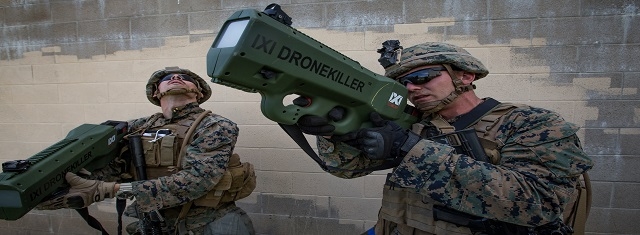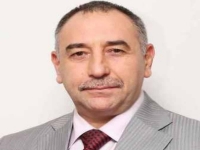Technology
The Revolution of Contemporary Military Technologies
Technical article

Cover of article
USPA NEWS -
The war environment is a major challenge for military leaders in the light of contemporary changes and transformations of warfare, as well as the diversity of tools and methods in the theatres of conflict and clashes, the complex wars taking place in the Middle East in particular and the world at large. And is fully consistent with the context of the composite war, [1] after the remarkable shift in the tendencies of terrorist organisations that are looking for power, land, and money, like parallel entities (non-governmental actors), imposing on military commanders realistic challenges, rethinking how these wars are fought, using Artificial Intelligence, self-regulation, and sensors everywhere, as well as space and air progress, and showing the costs of these capabilities high compared to the cheap cost of terrorist organisations and parallel entities in order to obtain justifications for military
New Techniques and Old Problems
The Foreign Affairs Magazine published a study entitled “The New Revolution in Military Affairs,“ in March 2019. [2] I mention some of the “Christian Bruce“ [3] in the search for real challenges The US military is opposed to the modern technological development race, and the traditional pattern of war contexts with rivals such as China and Russia, as they mentioned, under the title “New technologies and problems are old.“Artificial Intelligence“ and other emerging technologies will change the way war is fought, but will not change its nature? Whether it contains long arcs or source code, the war will always be violent and politically motivated, and consist of the same three basic functions that recruits learn in basic training; movement, fire, and communication.
The Foreign Affairs Magazine published a study entitled “The New Revolution in Military Affairs,“ in March 2019. [2] I mention some of the “Christian Bruce“ [3] in the search for real challenges The US military is opposed to the modern technological development race, and the traditional pattern of war contexts with rivals such as China and Russia, as they mentioned, under the title “New technologies and problems are old.“Artificial Intelligence“ and other emerging technologies will change the way war is fought, but will not change its nature? Whether it contains long arcs or source code, the war will always be violent and politically motivated, and consist of the same three basic functions that recruits learn in basic training; movement, fire, and communication.
Technology will reduce the need for large, risky and expensive military logistics networks by enabling the production of complex goods at the point of demand quickly, cheaply and easily. Technology will radically change how armies launch fire, and cyber attacks, jamming communications, cyber warfare, etc. Of attacks on system software, as important as attacks on system devices, if not more, and the rate of fire, or how fast the fire will be, thanks to new technologies such as laser, high-power microwave devices, and other weapons directed energy, but what actually will increase the fire rate is intelligent systems radically reduce the time period between the time in which it can set goals and when to attack
Brain-Computer Interface (BCI) Technology
The new technologies will transform military communications, and the 5G-based information networks will be able to transmit much larger amounts of data much faster, give armies the ability to handle data volumes, and solve problem categories beyond the power of classic computers. The Brain-Computer Interface (BCI) technology, which enables humans to control complex systems, such as artificial prostheses and even unmanned aircraft, with their nerve signals, simply enables the human operator to control several unmanned aircraft by thinking about what that these systems will do together, and as the research says that all these techniques will replace the assumptions of decades, and even centuries, on how the armies work, the armies that adopt these techniques and adapt to them, will dominate the non-doing in this regard, Technical armament.
The new technologies will transform military communications, and the 5G-based information networks will be able to transmit much larger amounts of data much faster, give armies the ability to handle data volumes, and solve problem categories beyond the power of classic computers. The Brain-Computer Interface (BCI) technology, which enables humans to control complex systems, such as artificial prostheses and even unmanned aircraft, with their nerve signals, simply enables the human operator to control several unmanned aircraft by thinking about what that these systems will do together, and as the research says that all these techniques will replace the assumptions of decades, and even centuries, on how the armies work, the armies that adopt these techniques and adapt to them, will dominate the non-doing in this regard, Technical armament.
Replace the Human Element with Unmanned Power
The critical thinking of the most complex issues, especially in the military aspects, the context of the state´s preparation of the war, and the “Christian Brose.“ was admired by the fact that it simulates modern technological development, the context of developing tools of force, and how to obtain the platform of superiority over adversaries in the presence of wars and conflicts, as well as the challenges of financial funding. The basic challenges of substitution theory rather than development, no doubt what he said according to the capabilities of the United States and its global superiority, are logical because he thinks strategically. He explains the frantic competitive environment of companies in artificial intelligence, the development of military capabilities, and this area is not available for all countries, as well as the orientations of the major companies operating in this vital space.
The critical thinking of the most complex issues, especially in the military aspects, the context of the state´s preparation of the war, and the “Christian Brose.“ was admired by the fact that it simulates modern technological development, the context of developing tools of force, and how to obtain the platform of superiority over adversaries in the presence of wars and conflicts, as well as the challenges of financial funding. The basic challenges of substitution theory rather than development, no doubt what he said according to the capabilities of the United States and its global superiority, are logical because he thinks strategically. He explains the frantic competitive environment of companies in artificial intelligence, the development of military capabilities, and this area is not available for all countries, as well as the orientations of the major companies operating in this vital space.
This approach is based primarily on the use of advanced space capabilities as an alternative to simple military models and the replacement of the human element with the ability to carry out. It is fraught with many military and social dangers due to the diversity of the war environment, the different geo-military framework and the variety of military courses. The cost of space services, the time required for training and mastery of use, not to mention the demobilisation of professional combat human resources, raising the risk of social unrest and the level of armed violence, especially unemployment repercussions on the military community, Reflections are difficult to determine.
The course of the cheap war
Many countries use the principle of cheap war cost, which relies on irregular formations, regardless of their false names and banners, through ideological feeders, a handful of dollars a month, and equipment and light and medium weapons supported by some conventional heavy weapons. We find that the difference in the cost and the return, as it seems that this type of war is common in the Middle East now through the breeding and fission of terrorist organisations and armed militias, and the cloning of its models in many countries without taking into account the security and social risks of strategic areas that establish failed states, and swallow the States ctors, and in military standards, these cheap armed organisations constitute a factor of attrition, prolonging the war against the regular armies, establishing the environment of violence and terrorism, societal disintegration and demographic change.
Many countries use the principle of cheap war cost, which relies on irregular formations, regardless of their false names and banners, through ideological feeders, a handful of dollars a month, and equipment and light and medium weapons supported by some conventional heavy weapons. We find that the difference in the cost and the return, as it seems that this type of war is common in the Middle East now through the breeding and fission of terrorist organisations and armed militias, and the cloning of its models in many countries without taking into account the security and social risks of strategic areas that establish failed states, and swallow the States ctors, and in military standards, these cheap armed organisations constitute a factor of attrition, prolonging the war against the regular armies, establishing the environment of violence and terrorism, societal disintegration and demographic change.
But the new low-cost technologies mentioned above, such as unmanned aircraft and sophisticated laser weapons, can inflict human and moral losses on these large armies with small armaments, as well as its ability to disrupt primitive command and control systems and dismantle its communications.
The art of war and military science remains vital and evolving and looks for what is new and for each course the pros and cons as well as the cost and the return and the speed of achieving the goals in the least time and cost possible.
* Military expert ““ Head of Saqr Center for Strategic Studies
01 May 2019
________________________________________
1- See Muhannad Al-Azzawi, the Composite War, Saqr Center for Strategic Studies
2-https://www.foreignaffairs.com/articles/2019-04-16/new-revolution-military-affairs2-
3- CHRISTIAN BROSE is Head of Strategy at Anduril Industries, a Senior Fellow at the Carnegie Endowment for International Peace, and the author of a forthcoming book on the future of warfare. He was formerly Staff Director of the U.S. Senate Armed Services Committee. This article is adapted from a paper presented to the Aspen Strategy Group in August 2018.
The art of war and military science remains vital and evolving and looks for what is new and for each course the pros and cons as well as the cost and the return and the speed of achieving the goals in the least time and cost possible.
* Military expert ““ Head of Saqr Center for Strategic Studies
01 May 2019
________________________________________
1- See Muhannad Al-Azzawi, the Composite War, Saqr Center for Strategic Studies
2-https://www.foreignaffairs.com/articles/2019-04-16/new-revolution-military-affairs2-
3- CHRISTIAN BROSE is Head of Strategy at Anduril Industries, a Senior Fellow at the Carnegie Endowment for International Peace, and the author of a forthcoming book on the future of warfare. He was formerly Staff Director of the U.S. Senate Armed Services Committee. This article is adapted from a paper presented to the Aspen Strategy Group in August 2018.
more information: https://http://saqrcenter.net/?p=1208&fbclid=IwAR3Xp_KSgbP7S594kACENlW6DIxpq31q9GMQQRmmrNgLXJsI-DvObn4lAWM
Liability for this article lies with the author, who also holds the copyright. Editorial content from USPA may be quoted on other websites as long as the quote comprises no more than 5% of the entire text, is marked as such and the source is named (via hyperlink).






